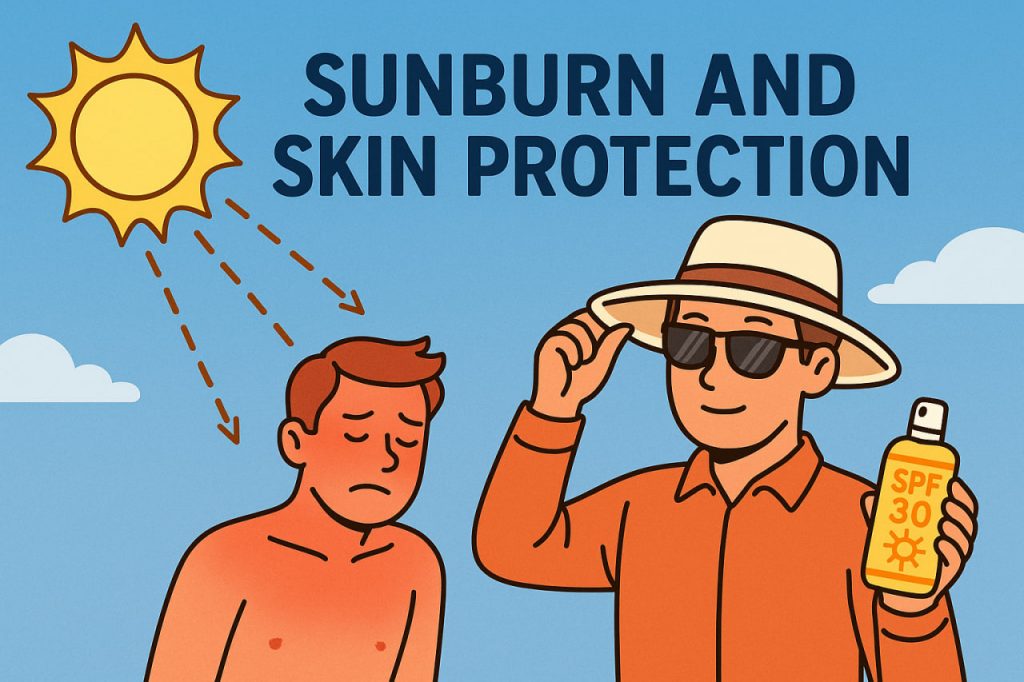Sunlight is essential for health and well-being—it boosts mood, helps the body produce vitamin D, and keeps our circadian rhythms in balance. But too much ultraviolet (UV) radiation from the sun can damage the skin, causing sunburn and increasing the long-term risk of skin cancer and premature aging. Knowing how to protect your skin is essential for staying healthy.
What Is Sunburn?
Sunburn is an inflammatory reaction to overexposure to UV rays, especially UVB rays. It occurs when the skin’s outer layer is damaged by radiation faster than the body can repair it.
Symptoms typically include:
- Red, tender, and warm skin
- Swelling or blistering (in more severe cases)
- Peeling after a few days
- Pain or itchiness
- Fever or chills if the burn is widespread
Sunburn can happen even on cool or cloudy days if UV levels are high.
How UV Radiation Affects the Skin
UV rays are invisible, high-energy rays emitted by the sun. There are three types:
- UVA: Penetrates deep into the skin and causes aging and wrinkles.
- UVB: Causes sunburn and damages the DNA in skin cells.
- UVC: Mostly absorbed by the Earth’s atmosphere and does not reach the ground.
Frequent exposure to UVA and UVB rays can lead to DNA mutations in skin cells, increasing the risk of melanoma and other skin cancers.
How to Prevent Sunburn
Protecting your skin doesn’t mean avoiding the sun completely—it means being smart about your exposure. Key prevention methods include:
- Use sunscreen: Choose a broad-spectrum SPF 30 or higher. Reapply every 2 hours, or more often if swimming or sweating.
- Wear protective clothing: Long sleeves, wide-brimmed hats, and UV-blocking sunglasses can shield your skin.
- Seek shade: Especially between 10 a.m. and 4 p.m. when the sun’s rays are strongest.
- Avoid tanning beds: Artificial UV rays are just as harmful.
- Check the UV index: This daily forecast helps you know when protection is most necessary.
What to Do If You Get Sunburned
If you do get sunburned, care is important to prevent complications and speed healing:
- Cool the skin with cool (not cold) baths or wet cloths.
- Moisturize with aloe vera or soothing lotions.
- Drink water to stay hydrated.
- Avoid further sun exposure until the burn heals.
- Сonsult a healthcare provider.
Avoid peeling the skin or using greasy creams, which may trap heat.
Long-Term Skin Health
Over time, repeated sunburns can cause lasting damage:
- Wrinkles and loss of skin elasticity
- Sunspots and discoloration
- Increased risk of skin cancers, including basal cell carcinoma, squamous cell carcinoma, and melanoma
Regular skin checks, sun protection, and awareness are key to long-term health.
Glossary
- Ultraviolet (UV) radiation – Invisible rays from the sun that can damage the skin.
- SPF (Sun Protection Factor) – A measure of how well sunscreen protects against UVB rays.
- Melanoma – The most dangerous type of skin cancer.
- UVA/UVB – Types of ultraviolet light, with UVA causing aging and UVB causing burns.
- DNA mutations – Changes in cell DNA that can lead to disease.


